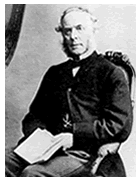 |
| Robert Fortune |
In my last article I explained how John Edward Gray FRS (1800-1875) of the British Museum (Natural History) in London obtained the two specimens he described in 1859 as a then new species, Cynops (now Paramesotriton) chinensis, the Chinese Warty Newt. They were in a bottle, along with a leech and two fancy goldfish, received from a Mr Fortune who collected them ‘inland from Ningpo’ (Ningbo).
The collector was not a name usually associated with zoological adventures, for the Mr Fortune was Robert Fortune (1812-1880), the famous plant hunter and horticulturalist who was an exponent of industrial espionage before the activity had a name. He travelled extensively in China, sometimes incognito, in search of plants and information on how to convert the leaves of the tea plant into the tea sold as a drink. Books and a film have described how he worked for the East India Company and of how the knowledge he gained was put to use in tea production in Assam and Ceylon (Sri Lanka) and thereby ensure that British India supplied the insatiable British market for tea. The article on Wikipedia states that he worked in China from 1843 to 1861. His first expedition was for the Horticultural Society in London.
I must now put the kettle on.
.jpg) |
| The Blue Plaque for Robert Fortune 9 Gliston Road, Kensingron, London (Simon Harriyott photograph) |
 |
| Chinese Warty Newt Showing the reason for its common name Photograph by Firedreams on Wikipedia |
 |
| Distribution of Paramesotriton chinensis from the IUCN Red List Classified as 'Least Concern' |
No comments:
Post a Comment